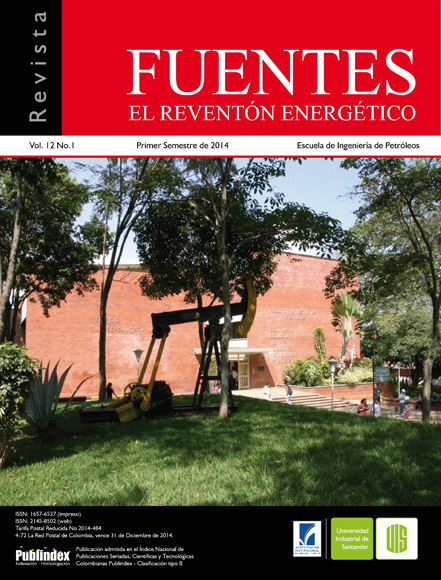Publicado 2014-08-22
Cómo citar
Resumen
RESUMEN
La combustión in situ es un método térmico de recobro mejorado de crudos pesados en el que una porción del petróleo se quema (cerca del 10%) a causa de la reacción con oxígeno o cualquier gas oxidante con el fin de generar energía en forma de calor. En el proceso de combustión, el aire inyectado reacciona con el aceite del yacimiento desencadenando las reacciones de baja temperatura (LTO, Low Temperature Oxidation) o reacciones de adición de oxígeno, posteriormente ocurren las reacciones de cracking (ITO, Intermediate Temperature Oxidation) las cuales producen el coque necesario para la combustión. Con el aumento de la temperatura se producen las reacciones de alta temperatura (HTO, High Temperature Oxidation) en las cuales se consume el combustible generando con esto el frente de combustión.
En este artículo se realiza una revisión de la cinética en procesos de combustión in situ, con énfasis en la combustión frontal seca para crudos pesados, que recopila los mecanismos de reacción de cada uno de los regímenes de temperatura y los modelos de reacción ampliamente reportados en la literatura junto con la cinética asociada a los mismos. Estos incluyen los modelos de Belgrave, Benham y Poettmann, Sequera, Kapadia, y Pruden entre otros.
El conocimiento de la cinética constituye un punto de partida para el análisis de procesos de combustión in situ, es necesario realizar pruebas de laboratorio con las que se pueda determinar la cinética de la reacción y determinar el conjunto de modelos de reacciones que mejor represente el comportamiento oxidativo del crudo objeto de estudio. El objetivo final de dicha revisión es determinar el modelo que mejor represente el comportamiento oxidativo de un crudo Colombiano.
Palabras clave: Crudo pesado, Combustión in-situ, Reacciones Químicas, Yacimiento, Reactor, Modelos cinéticos.
Kinetics of in situ combustion process: a review of kinetic models
ABSTRACT
In situ combustion is a thermal enhanced heavy oil recovery method in which a portion of the oil is burned (approximately 10%) due to the reaction with oxygen or any other oxidant gas with the purpose of generating energy as heat. In this process air reacts with the reservoir oil (in situ) resulting the low temperature reactions (LTO, Low Temperature Oxidation) or addition reactions, later the cracking reactions take place (ITO, Intermediate Temperature Oxidation) which produce the coke necessary for the combustion. As the temperature increase, the high temperature reactions occur (HTO, High Temperature Oxidation) in which the fuel is consumed generating the combustion front.
In this article is done a theorical review of the kinetics on In Situ Combustion processes, with emphasis on dry frontal combustion for heavy oil, which collects the reactions mechanisms of each of the temperature regimes (low temperature or addition, intermediate temperature of thermal cracking and high temperature or breaking bonds) and the reaction models widely reported on the literature with the kinetic associated to there. These include the following models: Belgrave, Benham and Poettmann, Sequera, Kapadia, and Pruden, between others.
Knowledge of the kinetics constitute an start point for the process analysis on In Situ Combustion, its importance lies that for making an In Situ Combustion project, is necessary to make laboratory tests to determine the kinetics of the reaction and also, to establish the whole set of reactions that best represent the oxidative behavior of the studied oil. The final objective of this review is to establish the most representative kinetic models for the Colombian crude.
Keywords:Heavy Oil, In-situ Combustion, Chemical Reaction, Reservoirs, Reactor, Kinetics model.
